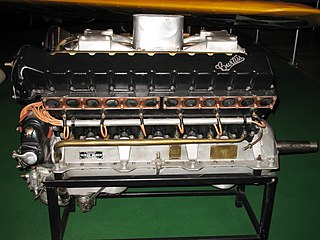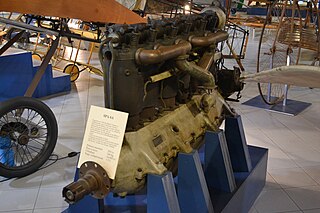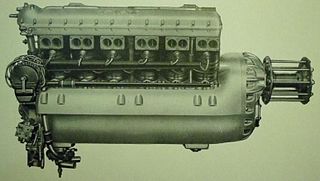
The Fiat A.80 was an 18-cylinder, twin-row, air-cooled, radial aircraft engine produced during World War II. Rated at 1,000 hp (745 kW), it was a more powerful development of the 14-cylinder Fiat A.74.

The Alfa Romeo 115 was an Italian six-cylinder air-cooled inverted inline engine for aircraft use, mainly for training and light planes, based on the de Havilland Gipsy Six engine. Production totalled approximately 1,600 units. Derivatives of the 115 include the -1, bis, ter and Alfa Romeo 116.

The Alfa Romeo 110 was an Italian four cylinder air-cooled inverted inline engine for aircraft use, mainly for trainers and light aircraft. The Alfa Romeo 110 was based on the de Havilland Gipsy Major, with approximately 500 units produced. Derivatives of the 110 include the -1, ter and Alfa Romeo 111.

The Fiat CR.1 was an Italian biplane fighter aircraft of the 1920s. Of wood-and-fabric construction, it was designed by Celestino Rosatelli, from whom it gained the 'CR' designation. Its most distinctive feature was that the lower wings were longer than the upper ones.

The Fiat A.74 was a two-row, fourteen-cylinder, air-cooled radial engine produced in Italy in the 1930s as a powerplant for aircraft. It was used in some of Italy's most important aircraft of World War II.

The Curtiss D-12, sometimes identified with the military designation Curtiss V-1150, was an aircraft engine of 18.8 liter displacement. It was a water-cooled V12, producing 443 hp (330 kW) and weighing 693 lb (314 kg). It was designed by Arthur Nutt in 1921 and used in the Curtiss CR-3 for the 1923 Schneider Trophy race. Fairey Aviation of England imported 50 Curtiss-built examples in 1926, renaming them the Fairey Felix.

The Isotta Fraschini V.4 of 1916 was an Italian six-cylinder, water-cooled, in-line piston aero engine of World War I. Its construction was fairly typical of aircraft engines of the period with six cast-iron cylinders mounted in pairs with common heads. This engine was also produced by Alfa Romeo.

For the aircraft of the same name, see Fiat AS.2 (aircraft)

The Fiat AS.3 was an Italian 12-cylinder, liquid-cooled V engine designed and built in the mid-1920s by Fiat Aviazione especially for the 1927 Schneider Trophy air race.

The Macchi M.41 was an Italian flying boat fighter prototype of 1927 designed and manufactured by Macchi. Its production model, the M.41bis, first flown in 1929, was in front line service from 1930 to 1938.

The Walter Bora was a Czechoslovakian nine-cylinder, air-cooled radial engine for powering light aircraft that was developed in the 1930s by Walter Aircraft Engines.

The Isotta Fraschini V.6 was an Italian six-cylinder, water-cooled, in-line piston aero engine of the late World War I period, the "V" denoted "Volo" or "flight". Its construction was fairly typical of contemporary aircraft engines, using six cast-iron cylinders mounted in pairs with common heads.

The S.P.A. 6A was an Italian aero engine of the World War I era. It was a water-cooled inline six-cylinder engine that produced 220 horsepower (164 kW).

The Fiat A.24 was an Italian water-cooled aircraft engine from the 1920s, built in modest numbers. It produced 520 kW (700 hp).

The Fiat A.30 R.A. was an Italian water-cooled aircraft engine from the 1920s, built in large numbers and serving with several air forces up to the beginning of World War II. It produced 447 kW (600 hp).

The Fiat A.22 was an Italian water-cooled aircraft engine from the 1920s. It produced 425 kW (570 hp) and powered several absolute world distance records as well as commercial passenger flights.

The Fiat A.25 was an Italian water-cooled aircraft engine from the 1920s. It produced 708 kW (950 hp) and was used by the Regia Aeronautica for fifteen years to power their Fiat BR.2 and BR.3 bombers.

The Fiat AN.1 was an experimental Italian water-cooled diesel straight six cylinder aircraft engine from the late 1920s.
The Piaggio P.XIX was an Italian aircraft engine produced by Rinaldo Piaggio S.p.A. during World War II and used to power aircraft of the Regia Aeronautica.

The Isotta Fraschini Asso 750 was an Italian W 18 water-cooled aircraft engine of the 1930s. Produced by Isotta Fraschini the engine displaced just under 48 l (2,900 cu in) and produced up to 940 hp (700 kW). Together with the Asso 200 and the Asso 500 the Asso 750 was part of a family of modular engines, that used common and interchangeable components to lower production costs.



















